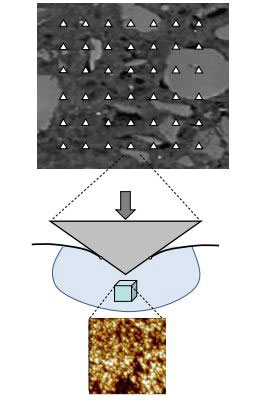Nanomechanical Testing and Multiscale Poromechanics
North Carolina State University
Problems
Materials commonly used in civil infrastructure, including cement, concrete and asphalt, as well as shales and mudstones frequently encountered in petroleum exploration and extraction, are multiscale heterogeneous porous composites. Multiple length scales, complicated chemical compositions, and varying microstructures in these materials present formidable challenges to researchers who seek to understand and model fundamental material behaviors. The complexity also hinders efforts by engineers to rationally optimize material properties and processes. Our research aims to provide insights into fundamental material behaviors by finding common links within classes of materials, and by understanding the mechanical microstructures that result in the wide variation of material properties. Experimental results and multiscale models are linked together to provide new insights at both small and large scales.
Approach
Our research probes the nanostructure and small-scale mechanical behavior of complex heterogenous materials. The primary research tools include nanoindentation testers and a nanoscratch tester, which provide continuous records of the load and displacement of a diamond tip with known geometry as it penetrates into a test material. For heterogeneous materials, we employ a grid nanoindentation technique (top figure) with hundreds of indents that probe composite behavior at smaller scales (bottom figure) using carefully chosen test parameters. This provides sufficient data to apply statistical deconvolution analysis that identifies properties and volume fractions of individual phases. Our group currently works to expand the application of these techniques to new materials and more difficult material behaviors, including viscoelastic and strength properties.

Findings
Recent research has focused on the small scale behavior of cements and concretes with enhanced sustainability, including the use of high volume fractions of fly ash, blast furnace slag, porous lightweight aggregates, and natural fibers. To help assess the long-term performance of these materials, their performance after fire damage was assessed. We found that hydration products of blended cements had the same nanoindentation responses as those from ordinary Portland cement, both before and after damage, but relative volume fractions differed. We have also found that the presence of porous aggregates changes the microstructure of cement hydration products. We hypothesize that these changes are related to internal curing, where secondary water stored in the porous aggregates is released some time later in the hydration process.
Impact
The production, transportation, and use of concrete accounts for between 5-9% of total CO2 emissions worldwide. Material modifications to reduce these emissions can only be rationally studied and designed with improved fundamental understanding of the origin of material behaviors. Similarly, improving the efficiency and safety of petroleum exploration and production in shales depends on fundamental understanding of mechanical behavior of the material.
Core competencies
- Grid nanoindentation experiments on heterogeneous porous materials
- Assessing nanomechanical morphologies and mechanical properties
- Multiscale poromechanics modeling for inverse problems, upscaling prediction, and optimization
Current research team members
- Yuriy Veytskin (Ph.D. candidate)
- Rahnuma Shahrin (Ph.D. candidate)
- Ye Zhang (M.S. candidate)
Recent Ph.D. graduates
- Vahid Zanjani Zadeh (2013), now at Bechtel
Current collaborations
- Cassie Hintz and Y. Richard Kim, NSCU, Nanoindentation investigation of viscoelasticity and cohesion of asphalt binder and mastic
- Korukonda Murty, NCSU, Assessing zirconium hydride nanostructures precipitating in zirconium alloys


